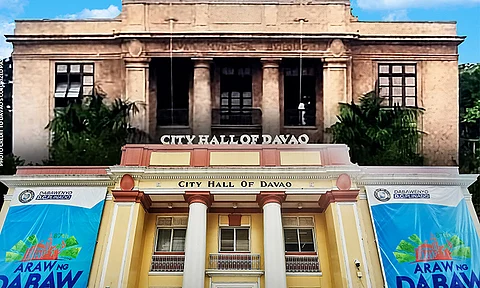

ON MARCH 1, 1937, Davao City was formally inaugurated, making it separate from the then-undivided Davao Province.
Former President Manuel L. Quezon, in his speech during Davao City's inauguration as a chartered city, as telephoned by the President to Executive Secretary Jorge Vargas, said that he is confident that the city officials he appointed would succeed in making the city a "progressive and model urban center."
To the people of Davao: The inauguration under its new charter of the city of Davao, important in international trade, brings to realization one of my long cherished plans of affording your city every opportunity to make great strides in its political, social, and economic development. I have selected as your Mayor a man long tried in municipal administration and I am confident that your city officials, with the wholehearted cooperation of all elements of the community, will succeed in making of Davao a progressive and model urban center
Former President Manuel L. Quezon
His vision came to fruition more than eight decades later.
The city has stood out from all the ups and downs. From its humble beginning to the present, there is no doubt that the city’s rich history has brought where it is right now - one of the largest and most progressive cities in the Philippines.

Early days
Davao, in its early beginnings, was mainly inhabited by the lumad and Moros.
The name, in fact, is the result of blending the three words “Dabo”, “Duhwow”, and “Davoh”, which the three Bagobo subgroups, Tagabawa, Guiangan, and Obo, named the Davao River.
Like any other part of the country, Davao City was also colonized by the Spaniards. Although, in the 16th century, they were just exploring the Davao Gulf area. It was not until 1844 when the Spanish Governor General of the Philippines Narciso Clavería ordered the colonization of the Davao Gulf region, including what is now Davao City.
Colonization began in 1848, in an expedition led by José Cruz de Uyanguren of Vergara, Spain.
Datu Bago, a local chieftain, opposed the Spanish ruling in the Davao soil. He led a fierce battle against Uyanguren. However, the latter was defeated, thus, giving birth to the town of Nueva Vergara, the future Davao in 1848. Uyanguren, later on, became its first governor.
The Spanish control of the town was unstable at best, as its Lumad and Moro natives routinely resisted their rule.
After a long rule over the Philippines, Spain lost to the United States during the war in 1898. It was then that the Americans saw how good the land was in Davao.
Rapid economic progress was felt as migrants from Luzon and the Visayas, as well as from other countries, like China, Japan, and the United States, flocked to Davao.
In 1901, the municipality of Davao was established, the current Davao Region.
The Japanese began as imported labor, but they became enterprising as the years went by and managed to own land and increase their hold on the abaca industry by buying out from the Americans.
In the 1930s, the Japanese nearly controlled the place, dictating both the economic and political life of the town.
This situation so alarmed the national government that Davao City was established as a chartered city by joining the Guianga Municipal District and the town of Davao.
In this way, the local government would be appointed by Manila, thus lessening the political manipulation of the Japanese.
Road to cityhood
Pantaleon Pelayo Sr., a Davao delegate during the Constitutional Convention in 1934, denounced the control of the Japanese in Davao and their acquisition of land.
Davao assemblyman Romualdo C. Quimpo filed House Bill No. 609 on March 16, 1936, creating Davao City as a chartered city.
This paved the way for the city to become an “independent” city. Thus, President Quezon signed the charter on October 16, 1936 via Commonwealth Act No. 51. The law took effect on March 1, 1937.
It was one of the first two towns in Mindanao to be converted into a city, the other being Zamboanga.
Shortly after, the Japanese occupied the entire city during World War II on December 20, 1941.
Davao City remained strong despite the declaration of Martial Law in the 1970s, and the armed conflicts that surged in the 1980s.
After the Edsa Revolution, the city continued to rise and began to move towards development. Advancements in technology, infrastructure, tourism, and business were evident.
Growth remained steadfast, despite incurring social issues.

Life is Here
The city, at present, has lived with its slogan, Davao Life is Here. It is evident with the influx of migrants, who attested to the city’s livability throughout the years.
The city is one of the country’s highly urbanized cities even as it is the largest city in the Philippines in terms of land area. It is also the third-most populous city in the Philippines after Quezon City and Manila, and the most populous in Mindanao. According to the 2020 census, it has a population of 1,776,949 people.
The city is also part of the East Asian Growth Area, a regional economic-cooperation initiative in Southeast Asia.


The city has a projected average annual growth of 2.53 percent over a 15-year period; Davao was the only Philippine city to reach the top 100 fastest-growing cities and urban areas in the world. As the largest city economy in Mindanao, Davao City also serves as the largest local economy in the southern Philippines.
As the city is just years away from reaching a centennial milestone, expect more progress and development, this time, with the hope to live sustainable progress for the future Dabawenyos. RGL
(Editor’s note: The information in this article was sourced from Museo Dabawenyo, and Davao History by Ernesto Corcino)